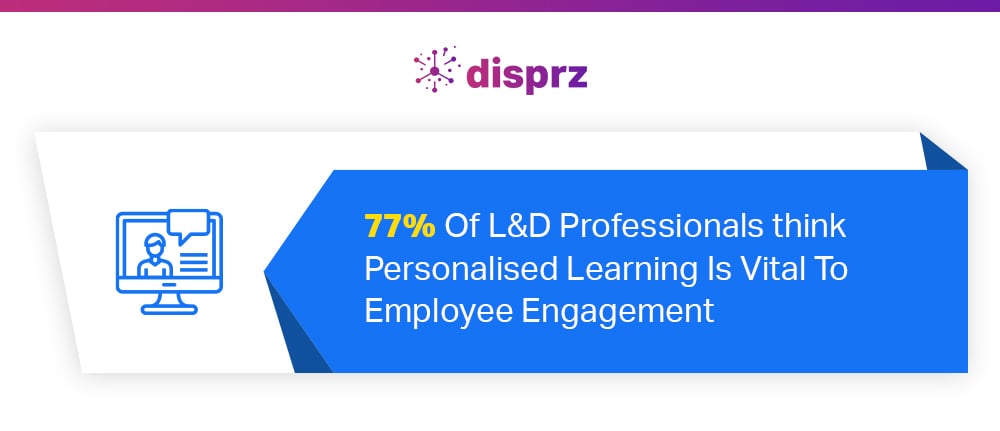From Amazon’s personalized product list for enticing a prospective buyer to swipe the card to Netflix’s binge-worthy recommendation to ensure a user extends the subscription, personalization is everywhere.
The “Just for me experience” is the hook that attracts prospective buyers to a platform and propels them to stay there. The same strategy can be used for learning and development
We all appreciate when our unique preferences and requirements are given importance. Employees feel the same when the learning experience is personalized for them. Personalized learning engages employees and enhances on-the-job training experiences.
What is personalized learning?
Personalized learning is a learner-centric approach that tailors learning to individual employees’ needs, abilities, and skill gaps. It is the perfect alternative to the so-called traditional one-size-fits-all approach, where everything from courses to assessments is generic due to the focus on mass learners. Being in the same team, employees can be at different skilling levels and have different interests. Hence it is imperative to build a personalized learning path that’s relevant to each employee.
Why is personalization important, and what role does it play in on-the-job training
Time is a scarce resource, and employees won’t waste it on consuming content that is not aligned with their interests or career aspirations. Personalized learning training is a great way to save time and motivate employees to learn on the job by giving information they need for skill development.
On-demand content in real-time is crucial to make any on-the-job training successful. If the on-demand content is personalized and responds to needs, it will receive more engagement.

Personalization is a trigger point that can propel employees to make learning a part of their daily work routine. For instance, an assistant product manager aspires to become a product manager. So he is introduced to a personalized learning pathway that can help him take the big leap in his career. The assistant product manager will willingly engage with the personalized content whenever he gets time at work to develop the skills required for becoming a product manager.
Personalizing on-the-job training helps get better outcomes as employees enhance capabilities by choosing their preferred path and delivering optimum performance that contributes to better business impact.
4 Best practices for personalizing on-the-job training
Here are a few best practices for enhancing on-the-job training with personalized learning:

1) Identify skills for each role and find out skill gaps
Skill development is a major focus during on-the-job training. Providing personalized learning throughout the upskilling journey is imperative to identify the right skills for each role. For instance, a credit analyst might need accounting skills, computing, problem-solving, and risk analysis skills. While a relationship manager will need data management, strategizing, and verbal and non-verbal communication skills.
Create a skill catalog by listing the skills for each role in the organization. Assess the current skill level of each employee and find out which skills are currently missing.
This catalog and skills gap assessment help to offer personalized learning experiences by curating/creating content around the specific skills that the employee needs to develop.
Most employees aspire to advance in their careers, so the catalog and skill assessment will act as their roadmap. They will have a clear visual of the skills they need to develop to move to the next role. So accordingly, during their free time on the job, they can enroll in personalized courses and enhance their skillsets.
2) Leverage an LXP with AI capabilities
In the learning space, LXP has gained the reputation of being the skilling tool that can offer personalized learning experiences. It gives L&d the flexibility to contextualize content as per the learner’s unique needs.
The modern LXP solutions are powered by AI that offers personalized recommendations based on the employees’ interests and skills. For instance, with Disprz advanced LXP, the entire skilling cycle can be managed, and based on the skills defined, the AI provides personalized recommendations to employees. Through this smart software, L&D can even enable recommendations through email. So, learners can receive personalized recommendations in their inbox daily. They can conveniently enroll and learn on the job without any hassle.
3) Blend microlearning and personalization
L&D professionals can take on-the-job training to the next level by merging microlearning and personalization. The bite-sized content hardly fails to capture attention. If the knowledge nugget is blended with personalization, there are high chances it would propel a learner to complete the course.
Micro learning is quick. The small chunk of content requires less time to consume and digest. So, employees can easily learn and apply it to work. They access the personalized micro knowledge nuggets at the time of need.
Moreover, most advanced learning tools enable the L&D to present personalized content in the employees’ preferred language. Using flashcards in multiple languages, L&D can engage the distributed workforce and encourage them to upskill themselves while working.

4) Evaluate data and provide real-time feedback
Is personalization reaping fruitful results? It is important to find that out by digging deep into learning analytics. Which learning modules are getting the highest click, or which courses have a low completion ratio despite personalization? Keeping track of such data can help take real-time action to achieve the personalization goals.
Moreover, personalized learning is incomplete without timely feedback. While employees learn on the job, it is important to evaluate their performance to ensure the learning is converting into the desired outcome. Based on the performance gap, it is important to provide feedback to address the improvement areas. The feedback needs to be in two ways.
The L&D shouldn’t only provide feedback but even take feedback from the learner to understand how the employees perceive the learning programs and what’s holding them back from engaging in the sessions. The more information an L&D professional garners, the better s/he can personalize the learning experience on the job.
Leverage an Innovated LXP for Personalized Learning and OJT
For making training on the job successful, it is important to give employees the flexibility to pursue the best path suitable for them. L&D can do this through personalization. A tool like LXP can be a helping hand in providing impactful personalized learning experiences on the job. One of the leading Indian pharmacy retail chains amplified productivity by personalizing learning using Disprz LXP. They could keep their frontline workforce up-to-date through micro-learning content merged with AI content recommendations on how to stock up on medicines, prescribe the right drugs, etc. They experienced an 80% completion rate across all the stores.
Click here to read the full case study.










